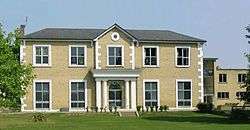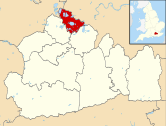St Paul's College, Sunbury-on-Thames
 | |
| Motto |
Disce prodesse "Achieving excellence, learning to serve" Lit: Learn to 'profit' or 'improve widely'[n 1] |
|---|---|
| Established | 1988 |
| Type | Voluntary aided school |
| Religion | Roman Catholic |
| Headteacher | James McNulty |
| Location |
The Ridings Green Street Sunbury-on-Thames Surrey TW16 6JE England Coordinates: 51°24′56″N 0°24′53″W / 51.4156°N 0.4146°W |
| Local authority | Surrey County Council |
| DfE number | 938/4610 |
| DfE URN | 125311 Tables |
| Ofsted | Reports |
| Staff | c. 90 |
| Students | c. 1080 |
| Gender | Coeducational |
| Ages | 11–18 |
| Diocese | Westminster |
| Website |
www |
St Paul's Catholic College is a Roman Catholic comprehensive secondary school and sixth form college in Sunbury-on-Thames, Surrey, England. St Paul's is a 1987 amalgamation of Cardinal Godfrey Boys' School and St Theresa's Girls' School both established in the early 20th century. The College is a specialist Technology College and an International School.
In performance, the secondary school has exceeded national average GSCE results since 2011.
Technology College
The Department for Education under successive governments have endorsed the school's designation as a Technology College. Technology College status reflects the enhanced opportunities in various sectors of these studies.
These opportunities arise in various types of applied Design and Technology, or enabled within the theoretical and skill-based studies of the sciences (including mathematics) and the arts. These opportunities, together with the annual adoption of educational innovations, form the cornerstone of the ethos of the school.
In furtherance of its specialisation this school has offered the option of studying an Engineering Diploma course to its pupils since September 2008.
Performance
The school in 2007-08 achieved an improvement in the proportion of five good A*-C passes of over 20%. Ceri Bacon was appointed to be the Headteacher in 2011 and at the close of that academic year presided over a 94.6% pass rate of five A*-Cs at GSCE level.[1]
Students’ attainment in 2010 represented a significant increase compared to previous years. This upward trend, although by a smaller proportion, continued in 2011, so that attainment in English by the end of Year 11 is now above the national average and around the national average in mathematics— School report by Ofsted, 2011
Wider ethos and motto
Provision for prayer and collective worship
- Prayer and worship underpin the Catholic life of the school so that pupils’ spiritual, moral and social development is outstanding.
- School Prayer
- We pray that we follow the teaching of St Paul:
- may we always speak the truth;
- share with others;
- use good words to encourage others;
- be understanding and forgiving.
- Grant us the strength to meet this challenge.
- Amen.
— Based on St Paul’s letter to the Ephesians 4:23-30
School motto and shield
Emblazoned onto the school uniform items is the school motto, DISCE PRODESSE which can rendered into English as: Learn (or study) to profit (improve).
The school's badge is a quartered shield divided into a capital S and P in authentic italic script, open book with quill symbolising the significance contribution St Paul made to the New Testament: thirteen epistles forming the New Testament book of Paul are attributed to St Paul and the sword representing both St Paul's brave eloquence in preaching the Word of God and the manner of his martyrdom: he was beheaded in Rome.
History
Administration building
The elegant two-storey, tall-ceilinged house with many windows formed the heart of St Theresa's Convent School and forms the staff and administration building. It is at the end of the Ridings in Green Street and was built during the reign of William IV, that is between 1830 and 1837 to designs by an unknown architect. It is a Grade II listed building. It has a simple Doric porch (portico), central round window and open pediment with two bays to either side. Under John Alliston it became the manor house during a period of the late Industrial Revolution with increasing population in the region, when the products of the manor's agriculture and fishing were insufficient to support the local population. The former manor house close to the Thames was rebuilt in 1851 as Sunbury Park House. These buildings were described as such in a map of 1865.[4] In 1898, it was the home of William Anthony Mitchison, who planted the 1 mile (1.6 km) avenue of horse chestnuts forming The Avenue in the east of his estate. Before the opening of Sunbury Police Station in 1882, Mr Mitchison, who was the local Justice of the Peace (magistrate) had special permission to conduct the court in a room of this grand house.[2][5]
After the death of Mr Mitchison, the house changed hands several times. It was owned at one time by a non-Catholic group who were not pleased that the newly built St. Ignatius’ Church could be viewed from their windows, so they decided to sell the house and lands. At some time the property was owned by Major Peters and his family. Major Peters had two sons, one of whom was killed in World War I and the other killed in a polo playing accident prompting its sale.
The Sisters of Charity of St. Paul purchased the house and lands in 1926. The Sisters worked in St. Ignatius Primary School which was next to the Church and the former smaller Catholic School opened in 1871, on Green Street.[4] A new building, consisting of three classrooms, a staff room and office, was built on the opposite side of Green Street to accommodate the increasing number of pupils.[5]
St Teresa’s Girls Covent School
At the same time the Sisters opened an independent school, convent school, in the main building. Its entrance gate was near where the present new St. Ignatius’ School was built. It led also to the stable buildings and houses for carriages. These were later converted into Art rooms for the school. A wall divided the circular driveway to the entrance hall from a large wooded area. Against this wall were planted apple trees specially grown for cider making. There was a large greenhouse in which was a vine reputed to be a cutting from the one at Hampton Court. The present playing field was originally divided by hedges into four fields. These fields were let to a shop owner on the Feltham Road. He grazed his ponies there and sold ice cream from carts drawn by the ponies.
Changes in the Education Policy meant that the independent school, St. Teresa’s, was no longer viable and it became incorporated into the public sector. To facilitate this change, the Sisters built a new school joined to the original building, as well as tennis courts and developed the playing field. At some time London Irish RFC used this field at weekends to train future members of the club. The reputation of St Theresa's became excellent.
Cardinal Godfrey Catholic Boys' School
Cardinal Godfrey School moved from its first home,the site of Echelford Primary School, Ashford to St Paul's site in October 1975 and is still demarcated in the school as the 'South Site'. The school grew from a very few classes to more than double the number in each year and established a good reputation.
Amalgamation 1988
During the summer term of 1987, it was decided to amalgamate the boys school and girls school into one unified school. In September 1988, St Paul’s Catholic School was formed. The name of the school was to honour the Religious Order that first established Catholic secondary education in this area; the Sisters of Charity of St Paul’s. Students from both schools were invited to enter a competition to design the school badge and tie. The winners were Carla James and Michael Brown.
Headteachers
External links
Notes and references
- References
- ↑ GCSE results 2012: Spelthorne and Runnymede 23 August 2012. Surrey Herald group of newspapers. Retrieved 2015-03-03
- 1 2 Prospectus (pdf) St Paul's Catholic College. pp: 2, 9. Accessed 2015-03-04
- ↑ Diocese of Westminster Educational Inspection Officer's Report, 2010 Accessed 2015-03-04
- 1 2 'Sunbury: Schools', in A History of the County of Middlesex: Volume 3 Susan Reynolds (The Victoria County History, London, 1962), pp. 64-65. Accessed 3 March 2015.
- 1 2 Historic England. "Details from listed building database (1180186)". National Heritage List for England. Grade II listing. Convent/manor house (central building). English Heritage. Accessed 2015-03-04.
- Notes
- ↑ A common meaning of 'prodesse' alone is usually on oneself however as with 'disce' in an educational context connotes the wider good to others, philanthropy, benefaction.
- ↑ Left on retirement after 18 years of leadership
- ↑ Successfully applied to become head of larger and then often academically-challenged St John Bosco College, London in a traditionally economically suffering part of Battersea, a position he holds as at 2015.
